main: February 2005 Archives
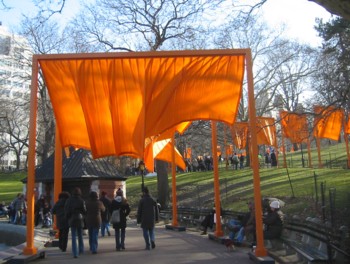
The Gates of Hell
There are three things Christo and Jeanne-Claude do not do together:
* They never fly in the same aircraft.
* Jeanne-Claude does not make drawing, she was not trained for that. Christo puts their ideas on paper, he never had an assistant in his studio.
* Christo never had the pleasure of talking to their tax accountant.
from "Common Errors" on the Christo and Jeanne-Claude Website.
Christo, whose work has always been more Euro-Pop than conceptualist, sometimes claims his work is primarily a matter of the aesthetic. This stops people in their tracks. He said this in Umbrellas, a well-received 1995 documentary directed by Albert Maysles, Henry Coora and Grahame Weinbrien about the Christo and Jeanne-Claude project involving the placement of giant very large umbrellas in Japan (blue) and California (yellow). Christo, usually patience personified, seemed to have lost his temper on camera when pressured to order the opening of the 1,230 Japanese umbrellas before he was ready to, because it was raining. His decision was a matter of aesthetics. Period. End of quibbling.
Are the large-scale Christo and Jeanne-Claude events, like the long-planned The Gates in Central Park New York City (February 12 to 27) primarily aesthetic? When it comes to The Gates, alas, yes. What was so powerful about Christo and Jeanne-Claude's Wrapped Reichstag (1995) was that it was not exclusively aesthetic; one cannot exempt what is wrapped from the meanings of the wrapping or vice versa. What was of interest in Valley Curtain (1972) and Running Fence (1976) was the sarcastic use of boundaries which must (unless you are tone-deaf to meaning) cast some reflection on boundaries and borders in real life. Christo was born in 1935 in Bulgaria, which suggests he might be aware of political dividing lines.
His off-the-cuff remark about aesthetics may have been situation-specific, but it can also be taken as a reflection of the artist's naivety -- or perhaps duplicity. Each project requires so much fund-raising and so much organizing of personnel that anything less than the aesthetic as content might stand in the way. Beauty, particularly when the word means the theatrical, sells. The process of large numbers of people setting up umbrellas or orange, pleatedcafé curtains on outsize door frames also attracts the unwary and the needful, so universal is the nostalgia for group activities and participation.
To give Christo and Jean-Claude their due, their projects do not utilize one cent of public money. They are mostly financed through very attractive, but academic, drawings that function as pre-souvenirs. This, and not any particular manifestation, is an earmark of their genius. They are, as they relate on their Website, their own art dealers, selling to "Museums, art collectors, art dealers and galleries." I say the projects are temporary, but the souvenirs are eternal. As are the thousands of professional and by now millions of amateur photographs taken of each temporary deportment of endless yards of fabric.
As an artist friend once told me, if an artwork can't be photographed, then it doesn't exist. This of course is a little different from the Christo projects. The difference is semantically subtle. Christo and Jean-Claude make art that's more than camera-ready; it exists only to be photographed. It is best enjoyed through a lens.
Unfortunately, if the Christo manifestations are meant to be primarily aesthetic and thereby to function as photo-ops - how old-fashioned -- then The Gates were not entirely successful. If you will excuse the pun, they did not hang together. Spread out along the pathways of Central Park, they were spread too thin. You needed to look at clots of them at certain angles to get any feeling of density. Up a hill, down a hill. Otherwise you had to wait for a breeze strong enough to make them billow and take on some form. People seem to like walking beneath them and certainly photographing them; some also wore orange in honor of the photo-op. But did we really need Christo/J.C. to tell us that Central Park is a really fine place for a promenade?

He Who Lives by the Camera...
In light of what I have written previously about photographing art, constant readers might be interested in my efforts to capture The Gates with my Elf. I had to struggle with intention. Did I want to make them look better than they were, or worse?
The trouble with allowing photography (whether digital or otherwise) to define the art is that imaging technology is more about framing and flattening than about truth. How do you capture within a frame how big and beautiful Central Park itself is, even in winter, in comparison to Christo's wee orange banners? How do you photograph the varied interaction between nature and culture all around you in contrast to the fabric flags planted like dotted lines along the already artificial hills and dales? Artifice disguised as nature, which is what Olmstead and Vaux achieved, does not need one more layer of artifice.
This is not to say that Christo and Jean-Claude will not come up with bigger and better projects. However, seeing The Gates in reality, rather than as preview drawings or through after-the-fact photographs, forces unfortunate comparisons. It makes one wonder about previous Christo projects. Were they equally unimpressive to the untamed eye? And here's the real subject to chew on: Does it make any difference?
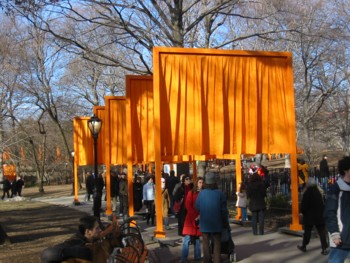
Another Big Subject
A topic worth looking at is how artists present themselves.
Take a good look at the Christo and Jeanne-Claude Website, particularly the section called "Common Errors." I both printed it out and saved it on my hard-drive for future use, because it turns out to be hilarious. It will certainly come in handy when and if I again conduct my popular, exhausting (for me), psychotherapeutic workshop called "How to Present Your Art and How to Present Yourself".
Yes, I was glad to know that the Christo and Jeanne-Claude never use volunteers, whereas I thought they did. Everyone is paid, except Jeanne-Claude's mother. Christo and Jeanne-Claude seem to make no profit at all and never take vacations. They are saints.
Although Christo and/or Jeanne-Claude love to scold journalists, we also learn the ins and outs of their names and how to correctly address them. Although Christo was originally the first name of the Bulgarian of the pair, their son has Christo as a surname. At one point Christo made academic portraits for a living. They still live in and sell their art in their Soho fifth floor walkup.
Fascinating.
P.S. Want an action-hero Andy Warhol doll, available in both a1960s and a 1980s version? Try this Japanese Website then search for Andy Warhol. I wonder if the silver wig comes off and if the 1980s doll has the gunshot scars....Could we also have Pollock and de Kooning action figures ? Or a Jeff Koons? How about an action-hero Clement Greenberg doll?
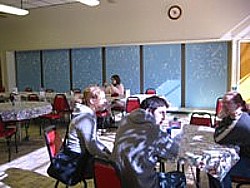
John Perreault, Toothpaste Mural II, 2005
"How to Innovate"
Lecture given at Cochise College, Sierra Vista, Arizona. February 2 and 3.
For better or worse, the art world puts a premium on innovation. Well, more or less. The history of modernism (and of its subset, postmodernism) is a history of innovations. Doing something new in the right way at the right time is rewarded, if not immediately, then sooner or later. We hope. Nowadays, unlike in the days of van Gogh or Gauguin or Picasso or even, more recently, Willem de Kooning, recognition tends to be quick. Why is this? Generations have been bred and fattened on the modernist legends, so no one wants to be embarrassed anymore by skipping over any new van Gogh; better to err on the side of too much acceptance too soon than on the side of ignorance.
Why innovation? Why the new? The modernist poet Ezra Pound once gave the advice to poets: make it new. He was in a new century, the 20th, and poetry like art had to be brought up to date. There was too much of a disconnect between art and everyday life.
But there are other reasons, in art at least, for making it new. That innovation in the past has been the sign of future greatness is the usual excuse, but the need for new products is a constant. The small pool of serious collectors, even though now global, needs to be tempted. Buying early is buying cheap, thus maximizing later profit. And although it now appears that the art market over the long run really doesn't do as well as the stock market, buying winning stocks offers little visual pleasure and less visible prestige. Most people don't hang their stock portfolios over the sofa.
Timing, of course, is crucial. I started by saying that innovation had to be done in the right way at the right time. The right way is a concept we cannot go into here, except to say that it probably has to do with breadth of product and product placement. But the right time is easy enough:
There were several others who spilled or splashed directly on the canvas before Pollock. André Masson was one, and even Miró did a splash or two. Janet Sobel was splashing around in the early '40s. But Pollock, along with doing it big and over and over again so that he established a signature product, also did it at exactly the right moment: the art world and the media needed a hero. Not a woman; not a Spaniard or a Frenchman; but an American male. In music we had Charlie Parker, who was a black man -- but he filled the bill. And more so. In acting, we had James Dean. It could have been Marlon Brando, but he just kept on living.
I think there is more to art than innovation. There is a spiritual core to art; nevertheless, its content needs to be communicated in an innovative way. The same old imagery will not wake us up. Then there is the matter of inspiration.
As a young man, in one of those life-changing happenstances, I (although born in the Village's St. Vincent's Hospital) found myself again in Manhattan, the center of all things bohemian. I was feeling frustrated about my poetry. Rimbaud had stopped writing poetry when he was 18. I was 23 and still not published, except for my college literary magazine. Every day I passed the New School on the way home from my job uptown at Brentano's Bookstore. I thought: why don't I see if there's a poetry workshop? There was, and it was offered by the New York School poet Kenneth Koch, whom I had never heard of. It turned out he was a wonderful teacher, and after one semester I won the Dylan Thomas Award. And it was through this poetry connection that I actually became an art critic.
One of the things I learned from Koch was this: you can't just sit around waiting for inspiration; it may never come. You can force it. And he gave us exercises that were really inspiration techniques: instead of verse, write prose poems; write a poem that is a list. Compose a fake dream. Restrict yourself: write a sestina, and so forth. He had learned all of this from the Surrealists I think, and from his artist friends. As in poetry, in art you can also force inspiration...
You can indeed sometimes start from inside, yielding to all kinds of weird pressures and dreams, but it is easier to start from outside as a way of getting in.
But before I reveal to you the secrets of innovation, there is one other thing you have to know. Too often we are burdened with what I call the communication or tin-can-telephone fallacy. Basically, this is the idea that the sender X has some information Y to be sent through W to Z. Which in art would go like this: you have something you want to communicate or to express, so you code it in a medium. The message you want to express is, let's say, "Life is beautiful." And since you are a painter, you decide to transmit this idea or feeling through paint on canvas that will be looked at by someone else. Meaning precedes the creation. But what we are doing is illustrating, not creating.
Try to think of art as a situation in which meaning follows creation. What the artist does is discover meaning after he or she creates; this is what Duchamp meant when he said the artist was a medium. But what about communication? That comes later; the communication or the transmission is a situation in which the receiver rediscovers or uncovers the meaning -- or even better yet, a new meaning. The meaning is in the feedback.
So here are some ways, with examples, of how to innovate in art through forcing inspiration:
Use a new methodology or way of making. Dripping, screen-printing, gnawing, lathering: Pollock, Warhol.
Use a new material. How about chocolate (Antoni) or toothpaste (Perreault)?
Copy something: Gorky copying Miró and Picasso, Pop artists copying comic strips, Malcolm Morley copying calendars or Vermeer; Mike Bidlo copying everybody. Copy yourself.
Put together two or more things that have not been joined before: obviously painting and sculpture (Robert Rauschenberg), art and theater(Rauschenberg), sound and vision, autobiography and abstraction.
Find a source outside art, or at least outside orthodox art. Cubism looked to African Art; Surrealism looked to South Pacific Art and North West Indian Art; Duchamp looked to alchemy and to the writing techniques of Raymond Roussel. Jean Dubuffet looked to the art of the insane, which he then called Art Brut.
Make it old. When painting is dead, surprise people by going back to painting; when abstract art is in the winning position, make realist art (Chuck Close).
Subtract something from art: representation, form, color, meaning. Is there anything else we can subtract? Conceptual art tried to remove even the physical, leaving only language (visible and in some cases oral). Can we then subtract language?
Add something to art: politics, feminism, personal narrative, objects. When it seemed as if art was just going to be empty colorless grids, a certain group of artists added color and decoration (Joyce Kozloff, Miriam Shapiro, Robert Zakanitch).
Redefine art. Duchamp said he was creating nonretinal art. Related to this is the following: try to make something that looks as little like art as possible.
Innovate out of ignorance. You can make something new simply because you don't know any better. Many Outsider Artists fall into this category. People such as Henry Darger don't break the rules; they don't even know the rules.
Break the rules, or create new rules.
But best of all, find a new way to innovate.
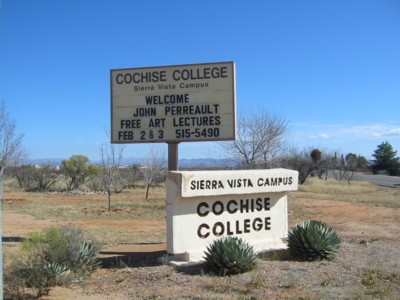
Paint It Red ( And Green and Blue and Yellow)
In Arizona last week, I also gave a lecture at the Tucson Museum of Art in conjunction with curator Julie Sasse's "Paint on Metal" (through May 1), a survey of just that.
In an effort to put the exhibition in a more critical context, I tried to probe the reason for the recent, but now thankfully abandoned, taboo against polychrome sculpture.
Of course, I had to bring up Rosalind Krauss' 1974 expose of Clement Greenberg's sanding down of some of David Smith's late, painted (or at least primed) sculptures. But I noted that, aside from the small issue of honoring authorship and the artist's intentions, aesthetically old Clem was probably right.
But we have to go back further than Greenberg; demonizing him is just immortalizing him. And why should we do that? He was right about Pollock and David Smith, but wrong about a lot else. And because of the good advice he gave far too many painters, he should also be remembered as a talented artistic collaborator.
We need to go back to the Greeks.
Greek sculpture was painted, as was the art of other polytheistic empires. For that little-known Ancient Cultures Disney effect, just take a look at the painted terra-cotta entablature of the neo-Classical Philadelphia Museum of Art.
Could antipolytheism be the origin of the polychrome taboo?
I ventured to mention the story of The Watchers in the apocryphal The Book of Enoch the Prophet ( 200 B.C.E?).
InEnoch, rediscovered in Ethiopia in 1773, the sons of God, mentioned in Genesis, become the "sons of heaven" (i.e. angels) and are called The Watchers.
After submitting to The Watchers, the human womenfolk "brought forth giants, whose stature was each three hundred cubits. They devoured all which the labor of men produced, until it became impossible to feed them; when they turned themselves against men in order to devour them; and began to injure birds, beasts, reptiles and fishes, to eat their flesh one after another and to drink their blood."
But here's the important part:
Azazyel, the leader of The Watchers, "taught men to make swords, knives, shields, breastplates, the fabrication of mirrors [more correctly, made them see that which was behind them] and the workmanship of bracelets and ornaments, the use of paint, the beautifying of the eyebrows, the use of stones of every valuable and select kind, and all sorts of dyes, so that the world became altered.
Enoch, as a few may remember, never died and was so favored by You-Know-Who that he was taken up physically to heaven. Nevertheless, in spite of Enoch's pleas, The Watchers are forever doomed. The use of paint, metallurgy and cosmetics is unforgivable. Things must look exactly as they are.
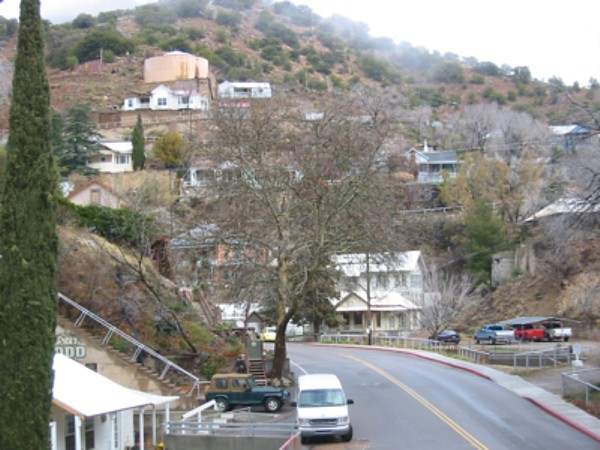
Tombstone Canyon Road, Bisbee
Coy Koi and the Golem
Then I juried an exhibition at the Central School Project in Bisbee, which has to be one of my favorite places: an old copper-mining town in the mountains, where (it's rumored) ancient hippies still hole up in caves. The Central School Project is an abandoned school purchased by 20 or so artists for studio space and public programs.I gave a poetry reading there, unveiling my Stolen Rhymes poems and ended with my first totally improvised-on-the-spot jazz poem. Stayed overnight at the funky 1890Inn at Castle Rock, formerly a miners' boarding house on Tombstone Canyon Road. "We are not normal" says their business card, but the breakfast is better than normal. The dining room surrounds a well-like pit that started out as a silver mine, then sprung a spring that became the Bisbee water supply, and now 30 feet below my cloth-covered table is home to those gigantic Japanese goldfish called koi, circling and circling in their mirrorlike prison.
Next day, a two-hour drive back to Tucson. Studio visits with both Jim Waid, a favorite painter of mine for many years. Through scraping layered surfaces he discovers "landscapes" that are internal/external. And Albert Kogel, a new favorite. Kogel'spaintings on carved sheets of wood are at the Davis Domingas Gallery in Tucson (154 E. 6th Street, to March 15).
Monday, I am off to Prague in search of the Golem. But also to write about the sculptorKaren LaMonte, who now works in the Czech Republic.
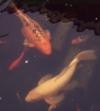
AJ Ads
AJ Blogs
AJBlogCentral | rssculture
Terry Teachout on the arts in New York City
Andrew Taylor on the business of arts & culture
rock culture approximately
Laura Collins-Hughes on arts, culture and coverage
Richard Kessler on arts education
Douglas McLennan's blog
Dalouge Smith advocates for the Arts
Art from the American Outback
For immediate release: the arts are marketable
No genre is the new genre
David Jays on theatre and dance
Paul Levy measures the Angles
Judith H. Dobrzynski on Culture
John Rockwell on the arts
Jan Herman - arts, media & culture with 'tude
dance
Apollinaire Scherr talks about dance
Tobi Tobias on dance et al...
jazz
Howard Mandel's freelance Urban Improvisation
Focus on New Orleans. Jazz and Other Sounds
Doug Ramsey on Jazz and other matters...
media
Jeff Weinstein's Cultural Mixology
Martha Bayles on Film...
classical music
Fresh ideas on building arts communities
Greg Sandow performs a book-in-progress
Exploring Orchestras w/ Henry Fogel
Harvey Sachs on music, and various digressions
Bruce Brubaker on all things Piano
Kyle Gann on music after the fact
Greg Sandow on the future of Classical Music
Norman Lebrecht on Shifting Sound Worlds
publishing
Jerome Weeks on Books
Scott McLemee on books, ideas & trash-culture ephemera
theatre
Wendy Rosenfield: covering drama, onstage and off
Chloe Veltman on how culture will save the world
visual
Public Art, Public Space
Regina Hackett takes her Art To Go
John Perreault's art diary
Lee Rosenbaum's Cultural Commentary
Tyler Green's modern & contemporary art blog
